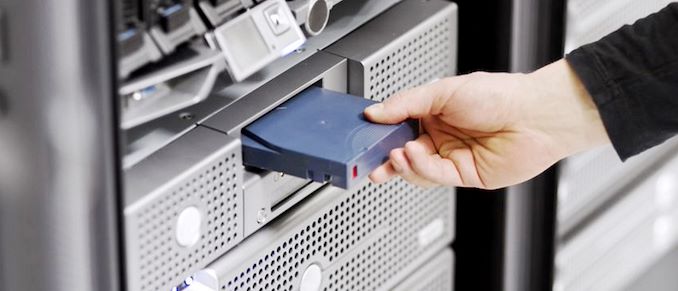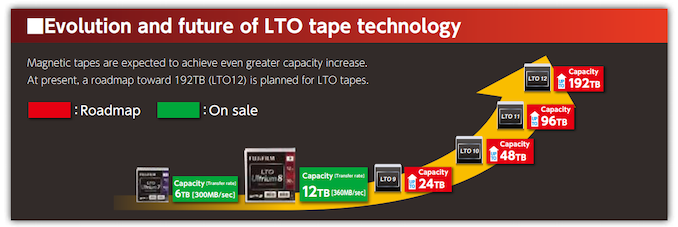400 TB Storage Drives In Our Future: Fujifilm
by Dr. Ian Cutress on June 30, 2020 8:00 AM EST
One of the two leading manufacturers of tape cartridge storage, FujiFilm, claims that they have a technology roadmap through to 2030 which builds on the current magnetic tape paradigm to enable 400 TB per tape.
As reported by Chris Mellor of Blocks and Files, Fujifilm points to using Strontium Ferrite grains in order to enable an areal data density on tape of 224 Gbit-per-square-inch, which would enable 400 TB drives. IBM and Sony have already demonstrated 201 Gbit-per-square-inch technology in 2017, with a potential release of the technology for high volume production in 2026. Current drives are over an order of magnitude smaller, at 8 Gbit-per-square-inch, however the delay between research and mass production is quite significant.
Strontium Ferrite would replace Barium Ferrite in current LTO cartridges. Strontium sits on a row above Barium in the periodic table, indicating a much smaller atom. This enables for much smaller particles to be placed into tracks, and thankfully according to Fujifilm, Strontium Ferrite exhibits properties along the same lines as Barium Ferrite, but moreso, enabling higher performance while simultaneously increasing particle density.
In standard LTO nomenclature, we are currently on LTO-8 where the drives have 12 TB raw capacity. Recent generational increases in LTO tend to double the capacity, so we’re looking at LTO-13 for 384 TB drives. Mellor indicates that there seems to be an average 2.5 years between commercialization of successive LTO drive standards, which leads to the following table:
| LTO Generation Progression | |||||||
| AnandTech | Standard | Retail | Length | Raw Cap. |
Speed MB/s |
Time to fill |
Material |
| LTO-1 | 2000 | 609 m | 0.1 TB | 20 | 1h23 | MP | |
| LTO-2 | 2003 | 609 m | 0.2 TB | 40 | 1h23 | MP | |
| LTO-3 | 2005 | 680 m | 0.4 TB | 80 | 1h23 | MP | |
| LTO-4 | 2007 | 820 m | 0.8 TB | 120 | 1h51 | MP | |
| LTO-5 | 2010 | 846 m | 1.6 TB | 140 | 3h10 | MP | |
| LTO-6 | 2012 | 846 m | 2.5 TB | 160 | 4h20 | MP/BaFe | |
| LTO-7 | 2010 | 2015 | 960 m | 6.0 TB | 300 | 5h33 | BaFe |
| LTO-8 | 2010 | 2017 | 960 m | 12.0 TB | 360 | 9h16 | BaFe |
| LTO-9 | 2014 | 2020 | 24.0 TB | *708 | *9h25 | BaFe | |
| LTO-10 | 2014 | *2022 | 48 TB | *1100 | *12h07 | Ba/Sr Fe | |
| LTO-11 | 2017 | *2025 | 96 TB | *1800 | *14h49 | SrFe | |
| LTO-12 | 2017 | *2027 | 192 TB | *2400 | *22h13 | SrFe | |
| LTO-13 | *2021 | *2030 | *384 TB | SrFe? | |||
| LTO-14 | *2021 | *768 TB | |||||
| *Unconfirmed/estimated | |||||||
Current generation LTO-8 cartridges take at least 9h16 to fill, with predicted speeds on future drives increasing that even further. Current LTO specifications go up to LTO-12, and so 400 TB would thus come in the LTO-13 generation.
Fujifilm states that 400 TB is the limit of Strontium Ferrite, indicating that new materials would be needed to go beyond. That said, we are talking about only 224 Gbit-per-square-inch for storage, which compared to mechanical hard disks going beyhind 1000 Gbit-per-square-inch today, there would appear to be plenty of room at the top if the technologies could converge.
Prices for current LTO-8 tape are the lowest out of all storage media. Depending on volume, prices around 0.8-1 cent per gigabyte is fairly common. Currently only Sony and Fujifilm are licencees to create LTO-8 media, however other companies such as HPE and IBM resell models under their own brand.
Source: Blocks and Files












32 Comments
View All Comments
s.yu - Tuesday, June 30, 2020 - link
No if you look at that table then it genuinely means that tape could replace HDDs. They're mere 200g each, are smaller than 3.5" HDDs, and already have respectable write speed, which would match current SSDs in a couple years...though I guess the main issue would be a lack of rated r/w cycles? Random r/w would probably be slow too, but still it could replace HDDs in certain consumer applications.MenhirMike - Tuesday, June 30, 2020 - link
Random R/W isn't just slow, it's orders and orders of magnitude slower. Tape marks make it somewhat fast to seek to a specific file on the tape, but then finding a specific position within a file will kill performance. Seek times are completely unusable as a hard drive replacement for anything but backups.MenhirMike - Tuesday, June 30, 2020 - link
(A 5400rpm Laptop drive will absolutely murder LTO-8 in performance. LTO is awesome because of the price and longevity of the tapes, not because of anything performance related.)MrVibrato - Wednesday, July 1, 2020 - link
True, generally tape is no replacment for HDD due to abysmal seek times. However, as s.yu said, for certain consumer applications that might not be so relevant.With regard to home users, the perhaps last/strongest holdouts for HDDs are data hoarding and media libraries. While most probably use streaming for their media consumption, perhaps there could be a resurgence of tape-based digital video for those who really like to keep everything local "on premises". Not that i really expect it to happen, but it would be kinda funny...
mode_13h - Saturday, July 4, 2020 - link
> for certain consumer applications that might not be so relevant.Um... besides backups, exactly which?
MrVibrato - Monday, July 6, 2020 - link
I mentioned two examples, none of them were backup... o.O?mode_13h - Saturday, July 4, 2020 - link
Yeah, it should have replaced "drives" with "tapes".Dogbertus - Wednesday, July 1, 2020 - link
Hate to quibble about grammar on Anandtech, but this particular quibble is one that I have faced as a technical writer. Is it necessary to invent "areal" density when the unit of storage (gigabits per sq. inch) is quite unambiguous? Specifying linear density is useful when referring to video tracks on tape since the length of a video track is more than the length of tape on which it is recorded, but "density" alone suffices for hard disks if a unit, say, Gb/mm was mentioned. Would my grammatic quibble change for overlapping, shingled tracks or those made by HAMR heads? I'm not sure and would be gratedul for pointers. Thanks. And apologies for the digression.cjl - Monday, July 6, 2020 - link
Areal density is pretty commonly talked about in HDD manufacturing too, to differentiate from linear density (along a track), track density, or storage server density (TB/drive or TB/U). It's been used for a long time, and is far from a new invention.mode_13h - Saturday, July 4, 2020 - link
I wonder if anyone ever uses these sorts of tapes in a RAID 5 set. Not only would you get faster read/write speeds, but you'd also be protected from one of the tapes getting physically damaged.